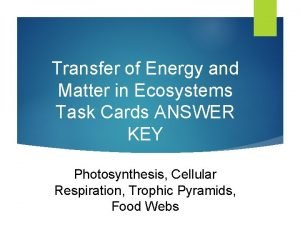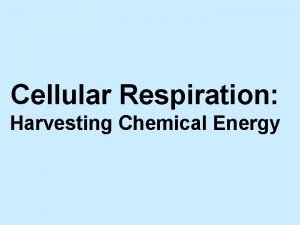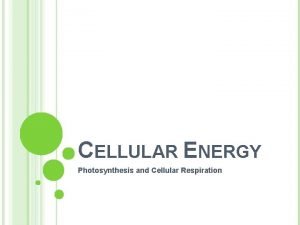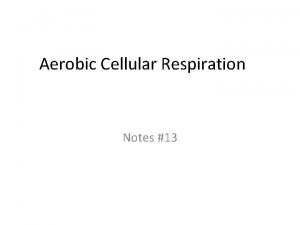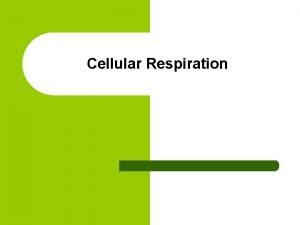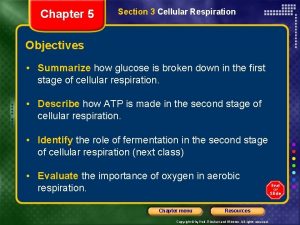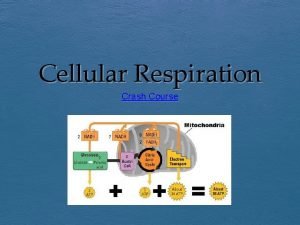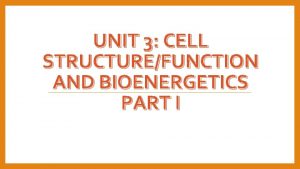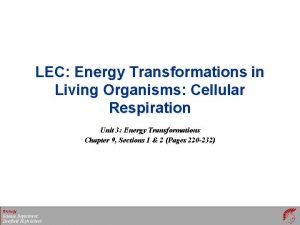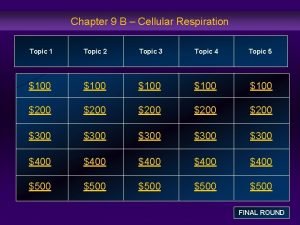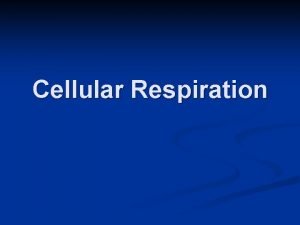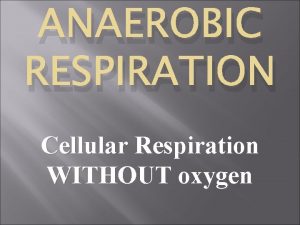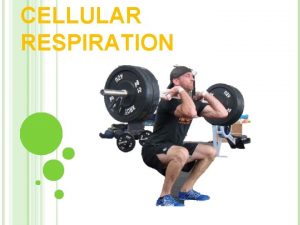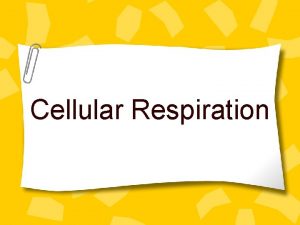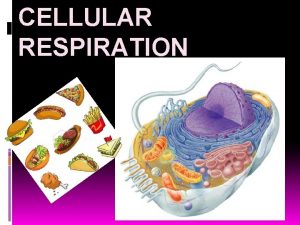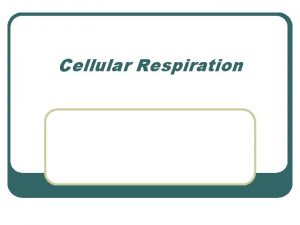Cellular Respiration Cellular Respiration Overview l l l


















- Slides: 18

Cellular Respiration

Cellular Respiration Overview l l l Transformation of chemical energy in food into chemical energy cells can use: ATP These reactions proceed the same way in plants and animals. Process is called cellular respiration Overall Reaction: – C 6 H 12 O 6 + 6 O 2 → 6 CO 2 + 6 H 2 O + ATP

Cellular Respiration Overview l l Breakdown of glucose begins in the cytoplasm, the liquid matrix inside the cell with a process called Glycolysis. At this point metabolism diverges into two pathways – – Anaerobic cellular respiration (aka fermentation) Aerobic cellular respiration

Anaerobic Respiration l l Glycolysis Fermentation – – Alcoholic (plants, yeast) Lactic Acid (muscle cells)

Aerobic Respiration l l Stage 1 - Glycolysis Stage 2 - Pyruvate Oxidation Stage 3 - Krebs Cycle (Citric Acid Cycle) Stage 4 - ETC (Oxidative phosphorylation) & Chemiosmosis

C. R. Reactions l Glycolysis – – Series of reactions which break the 6 -carbon glucose molecule down into two 3 -carbon molecules called pyruvate Process is an ancient one-all organisms from simple bacteria to humans perform it the same way Yields 2 ATP molecules for every one glucose molecule broken down Yields 2 NADH (electron carrier) per glucose molecule


Anaerobic Cellular Respiration l Some organisms thrive in environments with little or no oxygen – l l l Marshes, bogs, gut of animals, sewage treatment ponds No oxygen used= ‘an’aerobic Results in no more ATP, final steps in these pathways serve ONLY to regenerate NAD+ so it can return to pick up more electrons and hydrogens in glycolysis. End products such as ethanol and CO 2 (single cell fungi (yeast) in beer/bread) or lactic acid (muscle cells)


Aerobic Cellular Respiration l l Oxygen required=aerobic 2 more sets of reactions which occur in a specialized structure within the cell called the mitochondria – – 1. Kreb’s Cycle 2. Electron Transport Chain

Kreb’s Cycle l Completes the breakdown of glucose – – l Takes the pyruvate (3 -carbons) and breaks it down, the carbon and oxygen atoms end up in CO 2 and H 2 O Hydrogens and electrons are stripped and loaded onto NAD+ and FAD to produce NADH and FADH 2 Production of only 2 more ATP but loads up the coenzymes with H+ and electrons which move to the 3 rd stage


Electron Transport Chain l l l Electron carriers loaded with electrons and protons from the Kreb’s cycle move to this chainlike a series of steps (staircase). As electrons drop down stairs, energy released to form a total of 32 ATP Oxygen waits at bottom of staircase, picks up electrons and protons and in doing so becomes water

2 ‘s 32 ‘s

Energy Tally l l 36 ATP for aerobic vs. 2 ATP for anaerobic – Glycolysis 2 ATP – Kreb’s 2 ATP – Electron Transport 32 ATP 36 ATP Anaerobic organisms can’t be too energetic but are important for global recycling of carbon



 Overview of cellular respiration
Overview of cellular respiration Overview of cellular respiration
Overview of cellular respiration Total atp produced in cellular respiration
Total atp produced in cellular respiration Overview of cellular respiration
Overview of cellular respiration Cellular respiration
Cellular respiration Photosynthesis and cellular respiration diagram
Photosynthesis and cellular respiration diagram Cellular respiration equation
Cellular respiration equation Was ist fermentieren
Was ist fermentieren Aerobic cellular respiration
Aerobic cellular respiration Function of cellular respiration
Function of cellular respiration Aerbobic
Aerbobic Chapter 9 cellular respiration harvesting chemical energy
Chapter 9 cellular respiration harvesting chemical energy Overall reaction of cellular respiration
Overall reaction of cellular respiration Section 3 cellular respiration worksheet answers
Section 3 cellular respiration worksheet answers Cell respiration crash course
Cell respiration crash course Cellular respiration modle
Cellular respiration modle Cellular respiration
Cellular respiration Starting materials for cellular respiration
Starting materials for cellular respiration Chapter 9: cellular respiration: harvesting chemical energy
Chapter 9: cellular respiration: harvesting chemical energy





